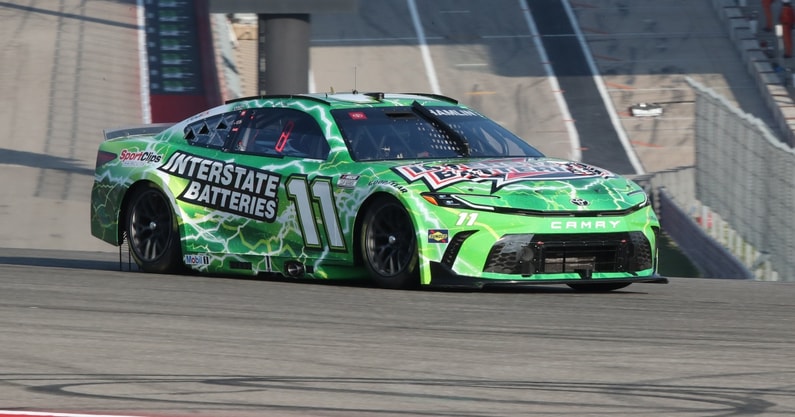Denny Hamlin asks NASCAR to use 'common sense rule' for track limits at road courses

Track limits played a big role in the NASCAR Cup, Xfinity, and Truck Series races this past weekend at the Circuit of The Americas (COTA).
NASCAR administered 40 penalties for short-cutting the course, with additional penalties handed down during practice and qualifying. Denny Hamlin, speaking on his “Actions Detrimental” podcast, called for NASCAR to use a “common sense rule” for track limits at road courses like COTA.
“NASCAR can’t have us running straight through the esses,” Hamlin said. “And that’s what we’d do if we didn’t have track limits. The difference is, is that other road courses, we have bigger curbs and things like that, that keep us off of it. But it still doesn’t change the fact that you know on restarts — a lot of these penalties we saw through the weekend came on restarts. It’s because you can’t see. I think that that’s the only place where we could really loosen up a little bit. Is that when the field is running two-by-two through the esses, no one is gaining an advantage. They’re just trying to gain line of sight.
“So, I think that you could just use a rule and it’s called the common sense rule. And that is that as long as someone does not gain an advantage by cutting the esses to get position maybe on someone on a restart, let the guys — give them a foot. Give them a little buffer zone.”
NASCAR exec Elton Sawyer admits there’s ‘work to be done’ on COTA track limits
Of the 20-turn, 3.41-mile course, drivers were penalized only for short-cutting the course through the esses. Sawyer said that drivers could shorten their lap time by short-cutting through the esses, thus the need to call penalties due to the advantage that could be gained.
NASCAR senior vice president of competition Elton Sawyer admitted on SiriusXM NASCAR Radio Tuesday that there’s “some work to be done” in officiating track limits moving forward at COTA. Sawyer added there’s been too much spotlight on officiating, and not enough on the drivers and their teams.
“COTA is very challenging,” Sawyer said. “I would rather go to Daytona, Talladega, Atlanta every day of the week from an officiating standpoint. We’re calling balls and strikes on every lap and that’s not really where we wanna be. I commend our team in the tower. I thought they did a good job. But it’s way too much about us and not enough about the athletes and our teams and our pit stops and strategy and things of that nature.
“So, [there’s] some work to be done. Not sure where the announcement is if we will or will not be going back to COTA in 2025. But we’re preparing today on what we can do going forward with the facility. And then how we would officiate it and what the deterrent looks like. Obviously, being out of bounds there and it being a drive-thru penalty, that’s significant. So, a lot of things for us to digest before we get back to COTA.”